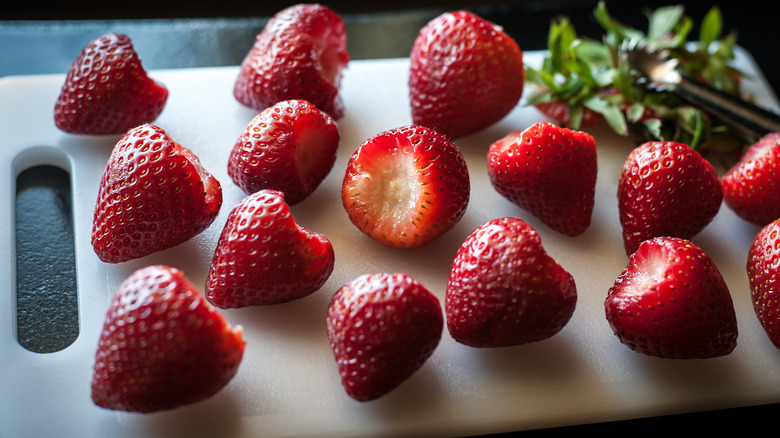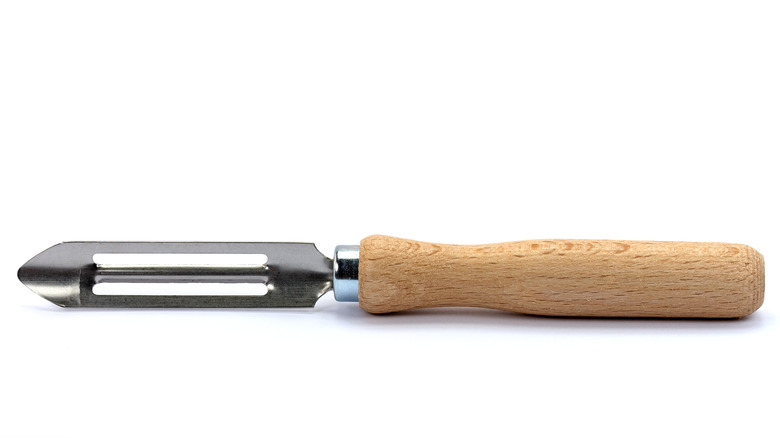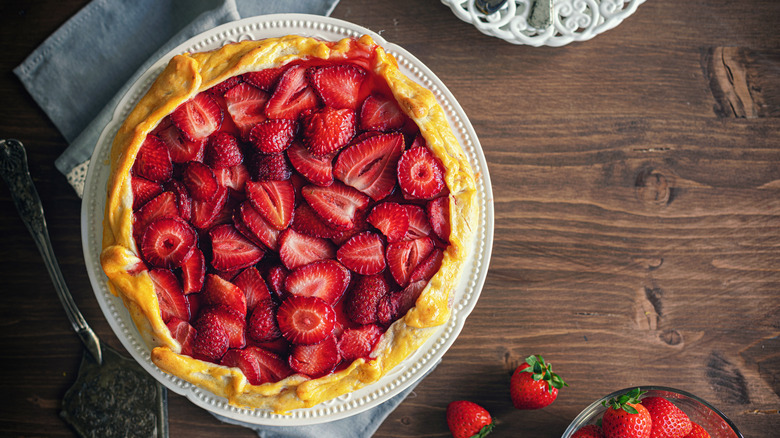Hull Strawberries Easier Than Ever With Your Trusty Vegetable Peeler
When eating fresh strawberries, or the chocolate-covered variety, you may be used to biting into the juicy fruit and discarding the stem. But when preparing strawberries to make compote or to top a cheesecake with rows of layered sliced fruit, it's best to hull them, or remove the stem and its connecting flesh. Though this might sound like a daunting task at first glance, you can do so seamlessly, by looking no further than your versatile vegetable peeler.
Since the hull is a bit bitter compared to the ripe sweetness of the rest of the berry, some recipes call for cutting this portion out with a paring knife to avoid wasting any of the still-perfectly-good top of the berry. And this is a skillful practice to get the best-looking strawberry tarts. Yet, it can be a little tricky to maneuver a small paring blade around the similarly small surface area of the berry, especially if your knife skills aren't the best.
Luckily, hulling a strawberry with a vegetable peeler couldn't be easier — that is, if you have a spiral peeler as opposed to the Y-shaped peelers with a horizontal blade, the spiral ones have a handle, vertical blade, and pointy top meant exactly for occasions like this when you need to get in there and remove some part of your produce — in fact, the top of these peelers are designed to remove potato eyes and other veggie blemishes.
How to hull your strawberries like a pro
Holding a vegetable peeler by its handle, you can simply rotate the pointy top blade around the stem of the fruit — no sharp paring knife or other special strawberry hulling equipment needed (though sure, you could buy a separate tool for the occasion if you're feeling fancy). To get the job done with precision, simply take a washed and dried strawberry, look the stem right in the eye, and pierce a spot along its outside circumference with the pointy edge of your vegetable peeler.
Next, carefully run the peeler in a circle around the stem, using a light up-and-down force (like when carving a pumpkin). Once you've cut around the stem, just deep enough to remove it, scoop the green, leafy portion out along with the white part of the fruit just at its base. And that's all there is to it; it couldn't be a simpler and easier process, with the help of your vegetable peeler. Continue the process with the rest of your strawberries, set the stems aside to compost, then slice or chop your fruit to use in mixed berry trifles or a variety of recipes.
Other tips for getting the most of your berries
Once you know how to hull strawberries with ease using your vegetable peeler, you're well on your way to crafting bakery-level showstopper desserts and striking sliced fruit and walnut salads. To preserve the moisture and vibrant color of ripe strawberry slices stacked on top of cakes or tarts, apply a light layer of simple syrup atop the fruit as a glaze. For baked fruit pies, sprinkle a little sugar on top of the fruit before you place your pastry in the oven, so the berries become glistening and extra sweet.
Even for strawberry syrups and sauces, where the appearance of the fruit is less important, you'll find that hulling helps yield the most tasty bits. Whatever culinary fate your berries face, taking the small extra step to remove the hull will result in the least waste in your kitchen as you render the sweetest, ripest parts to cook with. And a vegetable peeler makes the whole process easier. So, go on, break out your favorite strawberry recipes, and get ready to impress your friends when it's time for dessert.


